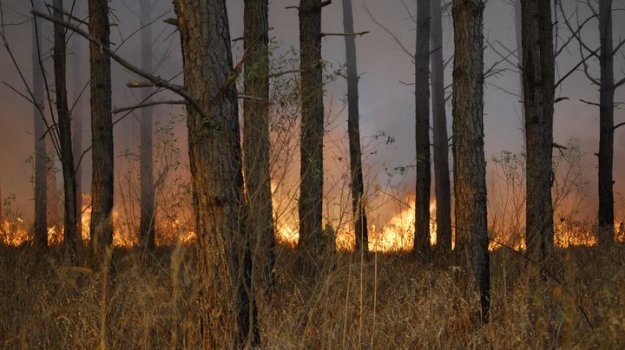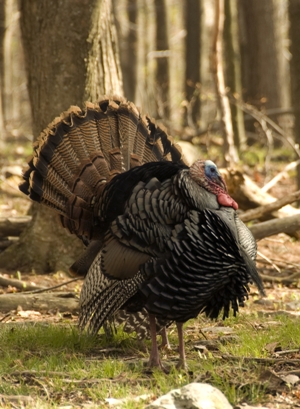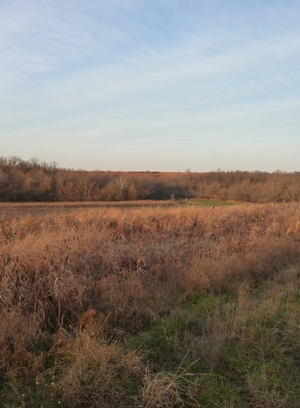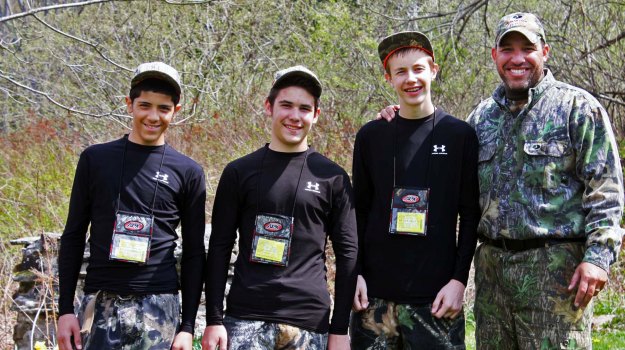
In Search of the Perfect Turkey Place
By David Hawley
Ever since I was old enough for rational thought, I have wondered what Heaven would look like. Would there be streets of gold leading up to a huge hilltop mansion? While we can gain clues from reading the Bible, we really have no way of knowing exactly what our eternal home will look like. Each person has their own opinion, typically formed in their imagination from a place or experience when they were at complete peace or in complete awe of the sheer beauty of their surroundings. So you might ask, “What is my opinion of Heaven?” It’s simple… daybreak in late March in an Alabama swamp with five to ten gobbling turkeys surrounding me.
I have long said that wild turkeys were our Creator’s finest work, besides humans of course. What other animal evokes the plethora of emotions as does the wild turkey? The wild turkey allows interaction, via calling. He is a beautiful bird, has uncanny senses, and provides an adrenaline rush to those who pursue him unlike any other animal, besides dangerous game perhaps, or bowhunting whitetails. Many people call wild turkeys stupid, but those same people likely haven’t hunted some of the “professors of hunter shame” I have hunted and probably hunt turkeys whose ancestors were not hunted at all. Simply put, in the Deep South, the wild turkey is as noble an adversary for the turkey hunter as Erwin Rommel was in the eyes of General George S. Patton.
So given the regality of the bird, would it be a stretch to suggest that Heaven has a healthy population of wily, crafty wild turkeys roaming its plains? I think not.
All we can do is speculate that Heaven will be in a constant state of springtime-with dogwoods and redbuds blooming and turkeys shouting their version of Amazing Grace. In the meantime, however, let’s discuss what the perfect turkey hunting place would look like here on Earth.
Based on my experience, there are two types of turkey hunting places; those suited for hunting and those suited for killing. I have been blessed to hunt to hunt some excellent places throughout the southeast, and some of the most beautiful to boot. What I have learned is that the most aesthetically pleasing places, like old growth hardwood river bottoms, are not the best places to give turkeys a ride in your truck.
I, along with my family, friends, and numerous folks from Mossy Oak and Biologic, have had the pleasure of hunting amongst a swath of land in west central Alabama and east central Mississippi known by the locals as the “flatwoods.” This area is essentially a 60,000 acre pine plantation with little or no elevation and very few hardwoods. When I think of sheer beauty, a pine plantation is not the first thing to come to mind, but in terms of killing turkeys, this area was in a different stratosphere.
The number of turkeys in this area at one point was staggering. The main reason was the low number of predators that called the flatwoods home. If you saw coyote scat or a possum crossed the road in front of you, it was a cause for conversation. As a result of the absence of predators, the recruitment rate from year to year was impressive, and there were always a healthy number of two year old turkeys to work with.
However, having tons of turkeys is fine and good, and you are undoubtedly playing a numbers game to some degree, but some places are set up so you can kill them better than others. Regarding the flatwoods, the first thing that came to mind was that there were no obstacles that created hang-ups…no creeks, thickets, fields, etc. It was simply a huge pine plantation that as a result of its timber management had little or no undergrowth yet was densely timbered enough to force turkeys to search for you. They were almost trapped.
 In big, wide open hardwood bottoms, turkeys can see a long ways. As a result, they tend to hang up right out of gun range and gobble and strut for hours on end. It makes for a beautiful hunt, don’t get me wrong, but if I want beauty I can go to Cades Cove National Park and watch semi-tame turkeys strut in lush hayfields on the side of the Smokey Mountains. I want beauty, but I also want a harvest and a side of celebratory pancakes.
In big, wide open hardwood bottoms, turkeys can see a long ways. As a result, they tend to hang up right out of gun range and gobble and strut for hours on end. It makes for a beautiful hunt, don’t get me wrong, but if I want beauty I can go to Cades Cove National Park and watch semi-tame turkeys strut in lush hayfields on the side of the Smokey Mountains. I want beauty, but I also want a harvest and a side of celebratory pancakes.
So if I had to draw up a paint-by-number turkey hunting place, what would it be? I would prefer a place with a 70-20-10 blend of timber, thickets/nesting areas, and fields/wildlife openings. Of the timber stands, I would have a moderate dose of old growth, bottomland hardwoods mixed in with massive pines with the majority being in various aged pine plantations. You needed diversity throughout your timber stands just as you need diversity in your place in general. Each block of pines would be on an intensive prescribed burn/herbicide schedule to prevent a heavy understory. I do not mind a light understory, so as to not feel “naked” when I am set up on a turkey, but turkeys simply cannot handle heavy cover.
There would be an extensive road system throughout the place, with primary roads up to sixty feet wide to allow for easy and safe travel for the birds, and secondary roads at least thirty five feet wide. You cannot undervalue a quality road system in terms of killing turkeys. Being able to quickly move throughout the turkey woods can be the difference in success and failure. Plus, wide roads allow you the ability to plant Clover Plus or strips of Whistleback on the sides, which turkeys love.
Turkeys also require nesting areas, so you’ll need either thickets (via cutovers or natural growth) or areas of native warm season grasses that will enable hens to protect their poults from predators. If I had my “druthers,” I would have five 40 acre thickets on a 1,000 acre place rather than two 100 acre thickets-with the reason being I personally feel you can spread the predators out a little more and make it tougher on them to work on the nests.
Regarding predators-the best investment one can make towards poult survival is a batch of live coon traps. I try to hit the small predators-coons, possums, skunks, etc.-year round and have seen a dramatic increase in poult recruitment. The flat-woods example above was proof that if turkeys do not get eaten as poults, they stand a much better chance of reaching maturity.
The reason I choose to focus on small predators is because of their limited range versus coyotes and bobcats, one can actually make a dent in their population. I do not need a biologist to tell me this, I have seen it with my own eyes. Coyotes and bobcats have a much larger range than small predators, and thus you are essentially fighting an uphill battle, so I chose to focus on the possums, coons, and skunks.
The last thing my turkey heaven would have would be fields. Because field turkeys are tough to kill (and I refuse to use a decoy), I would just assume there not be any fields, but from a management standpoint they are essential. Turkeys love frequenting openings in the spring, as lush grass, bugs, and safety are all found there. On rainy or windy days, you can almost guarantee that turkeys will head towards openings.
I would prefer two larger fields and several small plots or chufa patches scattered around. I believe that just as you manage the property as a whole, you should micro-manage wildlife openings as well. You must consider that every species of wildlife on your property needs these openings to survive. So offer something for everyone.
 Whistleback, as mentioned before, brings a new ingredient to the table in terms of managing for wild turkeys. 90% of landowner’s plant food plots for strictly whitetails, which I cannot fault them for, but a strip of Whistleback down the side of a Maximum field will give two targeted species of game the benefit of the field. Chufa is undoubtedly one of the best plantings for wild turkeys, and several one to two acre chufa plots scattered around will help hold turkeys. Clover Plus is a product we have had tremendous luck with, and it is a product that benefits both deer and turkeys. As noted earlier, it, along with Whistleback, are two great products to use on the sides of your primary roads.
Whistleback, as mentioned before, brings a new ingredient to the table in terms of managing for wild turkeys. 90% of landowner’s plant food plots for strictly whitetails, which I cannot fault them for, but a strip of Whistleback down the side of a Maximum field will give two targeted species of game the benefit of the field. Chufa is undoubtedly one of the best plantings for wild turkeys, and several one to two acre chufa plots scattered around will help hold turkeys. Clover Plus is a product we have had tremendous luck with, and it is a product that benefits both deer and turkeys. As noted earlier, it, along with Whistleback, are two great products to use on the sides of your primary roads.
Don’t forget mast and fruit producing trees-we have several fields lined with gobbler sawtooth oaks and autumn olives we have planted and they have been very popular with the turkeys. Nativ Nurseries has a number of species of oaks and wildlife trees that will benefit not only wild turkeys but deer, quail, etc. Visit www.nativnurseries.com for more info.
Overall, while hunting turkeys in a field can be frustrating, fields are essential for turkeys, especially for poults. Poults thrive off the bugs and ease of travel that most fields afford. Just remember to micro manage each field, particularly the larger ones, to maximize their usage by wildlife.
In summary, that is my idea of the perfect turkey hunting place and the steps to maintain that lofty status. However, just as the opinion of what Heaven looks like differs from person to person, there is no consensus, as hunters in different parts of the country may call their stomping grounds paradise. Also, the 70-20-10 formula I prefer may be different if it were in Kansas versus Alabama. Regardless, the bottom-line is this: give your turkeys shelter, give them plenty of food and water, and take away as many of their predators as possible and you will stand a great chance of creating a turkey heaven!






























